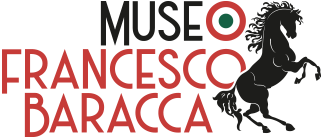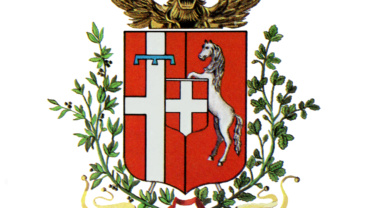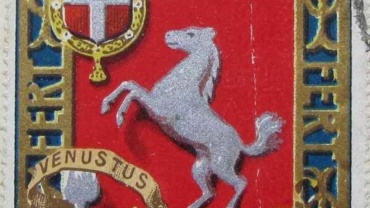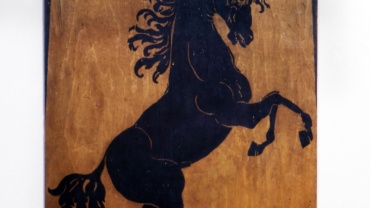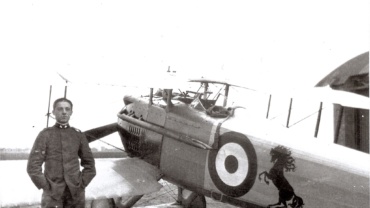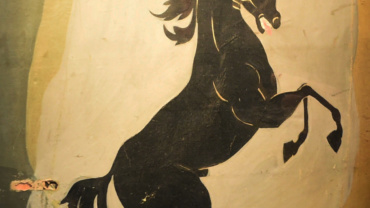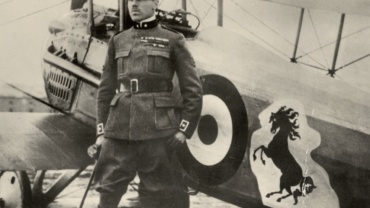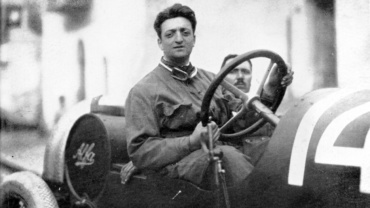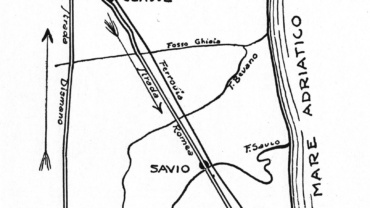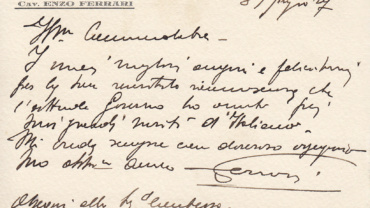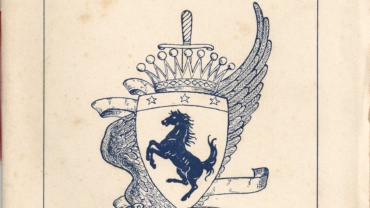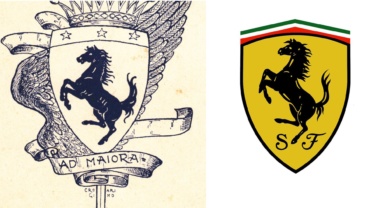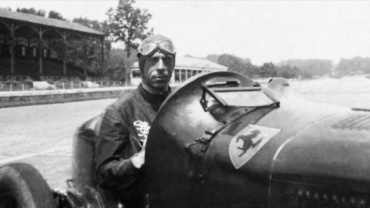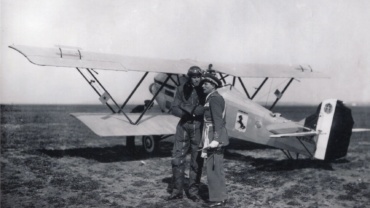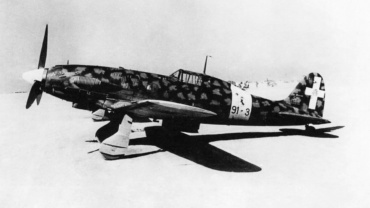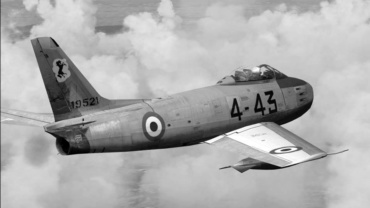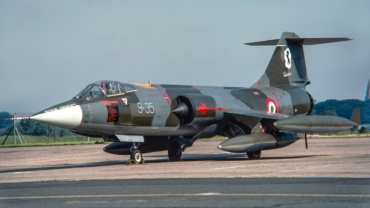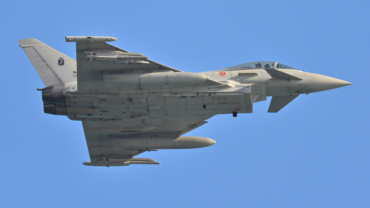The history
In the Military Bulletin published on the 3rd October 1909, Francesco Baracca, freshly appointed as a second lieutenant in the Cavalry, is assigned to the 2nd ‘Royal Piedmont’ Regiment, founded in 1692 by the Duke of Savoy with the motto ‘Venustus et Audax’ (‘Handsome and Audacious’). It is one of the most prestigious units of the Italian army and bears as its heraldic coat of arms the silver prancing horse on a red field, looking to the left and with its tail down.

Between the end of 1916 and the beginning of 1917, following the custom arisen among Italian aviators involved in the First World War, that was the attachment of identification marks to their aircraft, Francesco chose to adopt the same ‘Piedmont Cavalry’ coat of arms as a personal emblem. He just made some variations such as graphics and colours: he chose the black to make it stand out more on the canvas of his aircraft, claiming both his personal military origins and love for horses.
Francesco himself, in a letter to his mother dated 27 April 1918, explained the meaning of his personal emblem and the one of the 91a Squadriglia Caccia (91st Fighter Squadron), of which he was commander: ‘[…] I will soon send you a photograph of me on horseback. In the meantime, I send you this one of the aircraft with the horse, the emblem of Royal Piedmont. We have now adopted as the squadron’s badge a griffin, the symbol of daring and ferocity: the lion with the head of a falcon […]‘. As already mentioned, the little horse does not appear on the first aircraft flown by the Ace of Aces. The first evidence of the presence of a “pawing horse” on the nacelle of Nieuport 17 2614 is reported in an article of 8 May 1917 in “Il Resto del Carlino”, in reference to Francesco’s 8th victory on 26 April 1917 over Brandenburg C.I 129.17. The first photograph of Baracca with the prancing horse painted on the fuselage of a Nieuport 17 behind him was published in the magazine ‘Il Mondo’ on 20 May of the same year. The horse then passed on to the SPAD VII, and later, to the SPAD XIII, where it was painted on a white ‘cloud’ to make it stand out better against the camouflage colouring of this aircraft. It has now been proven that the horse was always black. Moreover, Francesco had it painted on both sides of the nacelle, until the griffin appeared on one of them. The wooden panel, exhibited at the funeral and kept by Baracca at his quarters until his death, shows the black horse looking to the right.
Gallery
The Prancing Horse and Ferrari
The origins of the prancing horse used by Ferrari were discovered when Enzo Ferrari published his memoirs entitled ‘My Terrible Joys’ in 1962. He wrote when he met Enrico Baracca, the hero’s father, during the first Savio motor racing circuit held in Classe (Ravenna) that he won in 1923. Later he also met his mother, Countess Paolina. Ferrari told that one day she gave him a photo of her son Francesco next to the plane with its prancing horse, saying: ‘Ferrari, put my son’s prancing horse on your cars, it will bring you luck‘. But at that time, Ferrari was a driver of Alfa Romeos and therefore could not have put the prancing horse ‘on his cars’.
Later, in 1929 he created the Scuderia Ferrari’ to manage the Alfa Romeo cars in sport and then the 9 July 1932, at the 24 Hours of Spa-Francorchamps (Belgium), the Alfa Romeos of the Scuderia Ferrari displayed the prancing horse symbol for the first time.
However, the little horse on the shield with its yellow background, the colour of Modena, was not exactly the same of Francesco Baracca. The graphics were different and, above all, the horse had its tail pointing upwards. The relationship between Enzo Ferrari, who had also become Alfa Romeo’s sales representative for Emilia-Romagna, and Count Enrico Baracca, an affectionate customer of Alfa Romeo cars, strengthened considerably over time.
In 1930, on the occasion of the inauguration of the hero’s shrine in Nervesa della Battaglia, a pamphlet entitled ‘Per Francesco Baracca sul Montello’ was published. The heraldic coat of arms of Enrico Baracca designed by Lugo painter Gino Croari was depicted on the cover, as is evident from the clearly legible signature.
Croari, in his freedom as an artist, had drawn the little horse by varying its style and representing it with its tail pointing upwards. That little horse is identical to Ferrari’s: same graphics, high tail, same shield. It is therefore easy to imagine that Enzo Ferrari, wishing to fulfil the countess’s wish, drew inspiration from Gino Croari’s little horse when defining the symbol of his team. In 1945 Ferrari had the prancing horse redesigned by the young Milanese engraver Eligio Gerosa, who designed the official logo of the Scuderia Ferrari two years later.
Gallery
The Prancing Horse in Aeronautics
Appearing for the first time on the Nieuport 17 in early 1917, the prancing horse is not only linked to the figure of Francesco Baracca but still represents an identity symbol of the Italian Air Force.
The personal insignia was created for practical purposes and used to identify individual pilots at a time when radio links between aircraft did not exist. They were painted on the aircraft and soon they became famous even among the combatants who watched the battles from the ground, as well as among those in the rear who followed the aviators’ adventures in the newspapers, becoming part of the legend of the “Knights of the Sky” of the Great War. Almost immediately Baracca moved on to fly the SPAD VII and the Cavallino followed him, later transferring to the more powerful and armed SPAD XIII, where it was painted in a white field to make it stand out better against the camouflage.
With Francesco’s death, the 91a Squadriglia Caccia (91st Fighter Squadron) was renamed ‘Baracca Squadron’, an honour never before given to a deceased aviator, while the Cavallino sporadically distinguished its aircraft in the 1920s.
To find the stable presence of the Cavallino as a departmental insignia, we have to wait until 1933, when the commander of the 4th Stormo, Amedeo d’Aosta, decided to adopt the prancing horse, accepting the suggestion of his flight aide Alessandro Bianchedi, who previously commanded the 91st Squadriglia.
The adoption of the Prancing Horse by this elite unit increased its popularity and since then, the emblem has been present in all the events of the Armed Force, moving to increasingly modern machines, painted on canvas, metal and finally on composite materials. Since 1967, the 9th Stormo has been named after Francesco Baracca, while the heraldry of Fighter Groups IX, X and XII, today mounted on Eurofighters, is inspired by the ace’s horse.
The radio call sign ‘Pony’ of the Frecce Tricolori was also dedicated to Francesco Baracca and his famous insignia, a reference wanted in 1960 by the Captain Zeno Tascio for the aerobatic patrol of the 4th Aerobrigata. The Pony remained in radio communications to perpetuate the link between Grosseto, base of the 4th Stormo, and Rivolto, where PAN still maintains its headquarters today.


